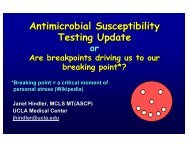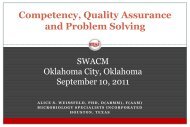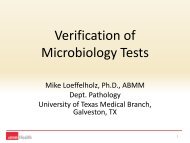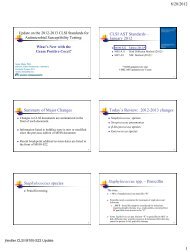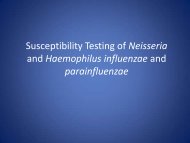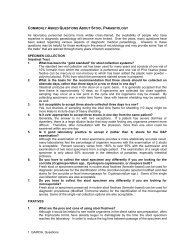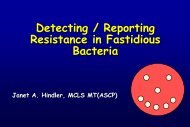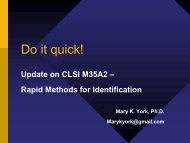(AST) Update by Janet Hindler, MCLS MT(ASCP) - SWACM
(AST) Update by Janet Hindler, MCLS MT(ASCP) - SWACM
(AST) Update by Janet Hindler, MCLS MT(ASCP) - SWACM
You also want an ePaper? Increase the reach of your titles
YUMPU automatically turns print PDFs into web optimized ePapers that Google loves.
Antimicrobial SusceptibilityTesting (<strong>AST</strong>) <strong>Update</strong><strong>Janet</strong> <strong>Hindler</strong>, <strong>MCLS</strong> <strong>MT</strong>(<strong>ASCP</strong>)Sr. Specialist, Clinical MicrobiologyUCLA Medical Centerjhindler@ucla.edu…also consultant with the Associationof Public Health Laboratories
At the conclusion of this talk, youwill be able to……♦Discuss detecting and reporting ofmultidrug-resistant resistant (MDR) gram-negativebacteria.♦Describe current recommendations forreporting vancomycin for Staphylococcusaureus.♦Discuss strategies for coping withcontinual changes in recommendationsfor <strong>AST</strong> and reporting.
Features…ESBLsMDRA. baumanniiP. aeruginosaE. aerogenesFeatures…MDR KlebsiellaOther MDR GNR
International effort ongoing tostandardize definitions for:♦MDR – multidrug-R(e.g., “R” to ≥ 3 drug classes)♦XDR – extensively drug-R(e.g., “R” to almost all classes but retains “S” to atleast one drug class)♦PDR – pandrug-R(e.g., “R” to all drug classes)Definitions apply to “acquired” (vs. “intrinsic”)) resistanceand to drugs that might be used to treat an infectioncaused <strong>by</strong> the species.
“Individual facilities should seek appropriateguidance and adopt effective measures that fittheir circumstances and needs.” (page 31)http://www.cdc.gov/ncidod/dhqp/
Specimen: FluidDiagnosis: Surgical wound infxnSerratia marcescensamikacinampicillincefazolinceftriaxoneciprofloxacingentamicinimipenempiper-tazobactamtobramycintrimeth-sulfaMIC (µg/ml)(1 S>32 R>32 R≤0.5 S≤0.25 S≤0.5 S>16 R≤8 8 S1 S≤1/19 SWhat about imipenem? cephalosporins?
Results verified with standard disk diffusion test…CeftriaxCeftazMeroImip
Appendix G. Screening and Confirmatory Testsfor Carbapenemases in EnterobacteriaceaeMHTCLSIM100-S19.
What are the mechanisms of carbapenemresistance in Enterobacteriaceae…♦Carbapenemase (β-lactamase that hydrolyzescarbapenems)– Exmp. KPC (Klebsiella(pneumoniaecarbapenemase)♦Cephalosporinase combined with porin loss– Some cephalosporinases (e.g., AmpC β-lactamases or ESBLs) have low-levellevelcarbapenemase activity– Porin loss limits entry of carbapenem into the cell
Modified Hodge TestS. marcescensweak positiveKPC pos. K. pneumoniaeATCC BAA-1705KPC neg. K. pneumoniaeATCC BAA-1706
Molecular testing revealed SME-2. Where doesSME fit among carbapenemases?MolecularClassABDCarbapenemaseKPCSMEalso IMI, NMC, GESMetallo beta-lactamases(IMP, VIM, GIM, SPM)OXAFound in:K. pneumoniae andother EnterobacteriaceaeS. marcescensEnterobacteriaceaeP. aeruginosa,Enterobacteriaceae,Acinetobacter,S. maltophiliaAcinetobacter baumanniiAdapted from Queenan & Bush. 2007. Clin Microbiol Rev. 20:440.
Some features of carbapenemases…CarbapenemaseKPCSMEMBLHydrolysis profile3 rd , 4 thgen cefs++/-+Aztreonam++-Inhibition profileEDTA--+Clavulanicacid++-3 rd gen cefs, , ceftriaxone, cefotaxime, ceftazidime4 th gen cef, , cefepimeMBL, metallo beta-lactamaseAdapted from Queenan & Bush. 2007. Clin Microbiol Rev. 20:440.
What is unique about SME as comparedto KPC?♦ Gene located on chromosome (vs. KPC on plasmid)♦ Less hydrolysis of ceftriaxone, cefotaxime,ceftazidime, cefepime than KPC (S.(marcescens “S”to these in vitro; ? activity in vivo)Majiduddin et al. 2005. Antimicrob Agents Chemother. 59:3421.Queenan et al. 1992. Antimicrob Agents Chemother. 44:3035.♦ Infrequently encountered:– 2000-20052005– 50,881 Enterobacteriaceae isolated from N. America, LatinAmerica, Europe– 5 SME (S.(marcescens)!Castanheira et al. 2008. Antimicrob Agents Chemother. 52:570.
Specimen: FluidDiagnosis: Surgical wound infxnSerratia marcescensFinal reportamikacinampicillincefazolinceftriaxoneciprofloxacingentamicinimipenempiper-tazobactamtobramycintrimeth-sulfaMIC (µg/ml)(1 S>32 R>32 R≤0.5 S≤0.25 S≤0.5 S>16 R≤8 8 S1 S≤1/19 SReport comment:“Imipenem-R R is due tocarbapanemase production(but not KPC). Theeffectiveness of β-lactams intreating infections due tocarbapenemase-producingproducingS. marcescens has not beenestablished. ID consultsuggested.”
Selective Reporting OptionSerratia marcescensamikacinampicillincefazolinceftriaxoneciprofloxacingentamicinimipenempiper-tazobactamtobramycintrimeth-sulfaMIC (µg/ml)(1 S>32 R>32 R≤0.5 S≤0.25 S≤0.5 S>16 R≤8 8 S1 S≤1/19 SSome may suppresscarbapenem result if “S” toceftriaxone and piperacillin-tazobactam….but, always report“unexpected resistance”.(CLSI M100-S19. Table 1.Note 1. p 33. )
http://www.cdc.gov/ncidod/dhqp/ar_kp_lab.html
MMWR March 20, 2009 (1)http://www.cdc.gov/mmwr/CRE = carbapenem-resistantresistantEnterobacteriaceae
MMWR March 20, 2009 (2)LaboratoryResponsibilities…Use reliable testmethods and reportCRE promptly!Surveillance
Specimen: BloodDiagnosis: Neutropenic feverKlebsiella pneumoniaeamikacinampicillincefazolinceftazidimeceftriaxoneciprofloxacingentamicinimipenempiper-tazobactamtobramycintrimeth-sulfaMIC (µg/ml)(32 R>32 R>32 R>32 R>32 R>2 R2 S>16 R128 R>10 R>4/76 RWhat about aminoglycosides?
http://www.clsi.org/Content/NavigationMenu/Committees/Microbiologygy/<strong>AST</strong>/<strong>AST</strong>.htm
http://www.bsac.org.uk/susceptibility_testing/guide_to_antimicrobial_susceptibility_testing.cfm
AAC(6’) “common” in S. marcescensDavid Livermore (BSAC website)
Specimen: BloodDiagnosis: Neutropenic feverKlebsiella pneumoniaeFinal Reportamikacinampicillincefazolinceftazidimeceftriaxoneciprofloxacincolistingentamicinimipenempiper-tazobactamtigecyclinetobramycintrimeth-sulfaMIC (µg/ml)(32 R>32 R>32 R>32 R>32 R>2 R≤0.12*2 S>16 R128 R1 S>10 R>4/76 RReport comment:“*No interpretive criteria availableImipenem resistance NOT due tocarbapenemase production.The effectiveness of gentamicin intreating infections due to K.pneumoniae that are gentamicin-S,amikacin-R R and tobramycin-R R hasnot been established. ID consultsuggested.”
Specimen: Tracheal AspirateDiagnosis: PneumoniaAcinetobacter baumanniiMIC (µg/ml)(amikacin>32 Rceftriaxone>32 Rcolistin≤0.5 Sciprofloxacin>4 Rgentamicin>16 Rimipenem>16 Rpiper-tazobactam>512 Rtigecycline 2*tobramycin>16 Rtrimeth-sulfa≤4/76 RWhat about tigecycline?* no interpretive criteria
Tigecycline – FDA Breakpoints(no CLSI breakpoints)Tigecyclinehttp://www.wyeth.com(Prescribing Information)
What should we know about testing/ reportingtigecycline on Acinetobacter baumannii?♦ Currently, no FDA approval for use in treatingAcinetobacter infections♦ Only breakpoints for Acinetobacter spp. availableare published <strong>by</strong> <strong>AST</strong> standards-type type organizationare from British Society for AntimicrobialChemotherapy (BSAC)http://www.bsac.org.uk/_db/_documents/– MIC (µg/ml)(≤1 1 S, 2 I, >2 2 R– Peleg et al. recommends using these for A. baumanniiinfections other than bloodPeleg et al. 2008. Clin Microbiol Rev. 21:538.
Why shouldn’t t we use the BSAC Acinetobacterspp. breakpoints for blood isolates?♦Maximum blood concentration =0.63 µg/ml– Prudent NOT to report blood isolates withMICs >0.5 µg/ml as “S”– Perform MIC not disk diffusion for bloodisolatesPeleg et al. 2008. Clin Microbiol Rev. 21:538.
What are the activities tigecycline andtetracyclines against MDR A. baumannii?%Susceptible (N=93)Tigecycl*MinoDoxyA-SAmikImipCiproPoly B9583562038200100*Used MIC breakpoint (S(≤2 µg/ml) for Enterobacteriaceae fromtigecycline product package insert (Wyeth Pharmaceuticals Inc.)Scheetz et al. 2007. Antimicrob Agents Chemother. 51:1621.
What are the activities of tigecycline andminocycline against MDR A. baumannii?Tested:Amp-sulbPip-tazoAztreCeftriaxCeftazCefotaxCefepimeImipMeroCiproOfloxSXTTetraGentTobAmikIsolatePDRXDRIPM-STotalN464064150TigecyclineMIC (µg/ml)(Range0.5-80.25-40.03-20.03-890%2222Range0.25-160.25-32≤0.06-16≤0.06-32MinocyclineMIC (µg/ml)(Excluding tigecycline and minocycline….PDR = R to all including colistinXDR = only S to colistinIPM-S S = variable90%1616816%S8.73060.936.6Arroyo et al. 2009. Antimicrob Agents Chemother. 53:1295.
Method-related discordance in tigecyclineMICs for Acinetobacter baumannii (N=227);Etest vs. broth microdilution (BMD)MIC 90 : Etest = 4 µg/ml BMD = 1 µg/mlPillar et al. 2008. J Clin Microbiol. 46:2862.See also...Casalet al. 2009. J Antimicrob Chemother. 64:69.
Specimen: Tracheal AspirateDiagnosis: PneumoniaAcinetobacter baumanniiFinal ReportMIC (µg/ml)(amikacin>32 Rceftriaxone>32 Rcolistin≤0.5 Sciprofloxacin>4 Rgentamicin>16 Rimipenem>16 Rpiper-tazobactam>512 Rtigecycline 2*tobramycin>16 Rtrimeth-sulfa≤4/76 RReport comment:“*No interpretive criteria;Infectious Diseasesconsult suggested.”
Specimen: Pleural fluidDiagnosis: PneumoniaStaphylococcus aureusMIC (µg/ml)(clindamycin>8 Rerythromycin>8 Roxacillin>16 RpenicillinRvancomycin 2 SShould we do anything aboutvancomycin MIC of 2 µg/ml?
S. aureus - VancomycinMIC Interpretive Criteria (µg/ml)(Susceptible≤2VSSA≤1 vs 2 µg/mlhVISAIntermediate4-8VISAResistant≥16VRSACLSI M100-S19; Table 2C.hVISA (h=heteroresistant) no CLSI recommendations for detecting hVISA
Why does it matter if vancomycinMIC is 1 vs. 2 µg/ml?♦ Based on PK/PD, , there may be different clinicaloutcomes if vancomycin used for therapy♦ Infectious Diseases Society of America (IDSA)Guidelines; if vancomycin MIC is:– ≤1 µg/ml– maintain vancomycin trough serumconcentration of 15-20 mg/L– ≥2 µg/ml- use alternative treatmentRybak et al. Clin Infect Dis. 2009. 49:325♦ Increasing numbers of isolates with susceptibleMICs of 1 and 2 µg/ml (as compared to ≤0.5µg/ml)- referred to as vancomycin “creep”♦ Some suggest lowering the breakpoint to ≤1 µg/mlfor “S”.
Vancomycin MICs are “Creeping up”MRSA Blood Isolates 2001-2005 2005 (N=662)MIC testing performed <strong>by</strong> Etest methodSteinkraus et al. 2007. J Antimicrob Chemother. 60:788.See also…Wang et al. 2006. J Clin Microbiol. 44:3883.
Outcomes of Vancomycin Therapy in92 Patients with MRSA Bacteremia(2005-2007)2007)OutcomeOverall failureHospital length of stayVAN MIC ≥1.5(66 patients)24 (36.4)*21 (9.0-43.0)VAN MIC
What methods should we use for routinetesting of vancomycin and S. aureus?♦ Is Etest best?– More recent outcome databased on Etest♦ Method variability– Etest MICs higher than CLSIreference method MICs♦ Reproducibility of MIC testsgenerally +/- 1 two-fold dilutionMIC = 1.5 µg/ml
Vancomycin MIC (N=101 MRSA)Etest MICs > Reference Broth Microdilution and Agar Dilution MICsPrakash et al. 2008. Antimicrob Agents Chemother. 52:4528.See also…Hsu et al. 2008. Intl J Antimicrob Agents. 32:378.
S. aureus - Vancomycin MIC DistributionUCLA 2008 (889 MSSA, 662 MRSA)90% of isolates80706050403057.448.742.550.5MSSAMRSA201000.1 0.8=4Vancomycin MIC (ug/ml)CLSI reference broth microdilution method
Specimen: Pleural fluidDiagnosis: PneumoniaStaphylococcus aureusMIC (µg/ml)(clindamycin >8 Rdaptomycin0.5 Serythromycin>8 Rlinezolid1 Soxacillin>16 RpenicillinRvancomycin 2 S*Final report“*Vancomycin MIC determined <strong>by</strong> Etest method”
Specimen: BloodDiagnosis: EndocarditisStaphylococcus aureusMIC (µg/ml)(clindamycin>8 Rerythromycin>8 Roxacillin>16 RpenicillinRvancomycin ≤0.5 SCould this be hVISA?
What is hVISA*?♦S. aureus that show….– vancomycin MIC ≤2 µg/ml (S) <strong>by</strong> conventionalMIC tests– subpopulation of cells with MICs 4-8 µg/ml– associated with increase production of biofilm;more tolerant to “killing”;; poor patientoutcomes*heteroresistant VISA
What might an hVISAinoculum look like?Too few “NS” cells to detect withstandard inoculum size in routine<strong>AST</strong> (MIC & DD results will be “S”);often slower growingSIR≤0.5124816≥32= 1 bacteriumVancomycin MIC (µg/ml)(NS, not susceptible
What methods have been used todetect hVISA?♦ Population analysis/AUC (PAP/AUC)– Place high inoculum on agar with varying vancomycinconcentrations and divide <strong>by</strong> area under the populationcurve (gold standard)♦ Etest (test vancomycin and teicoplanin)– Macro method - high inoculum (McF(#2) on BHI– GRD (glycopeptide resistance detection)See Yusof et al. 2008. JCM. 46:3042♦ Screen plates– MHA + 5 µg/ml teicoplanin– Other screen platesGRD Etest
Outcomes in 250 patients withBacteremia due to hVISA or VS-MRSAInfection-attributable deathHospitalization duration, daysBacteremia, dayshVISA(N=27)12 (44)*12 (0-207)12 (1-123)123)VS-MRSA(N=223)81 (36)12.5 (0-184)2 (1-92)p.4.8.005Endocarditis5 (19)8 (4).007Osteomyelitis7 (26)16 (7).006*No. (%) of patients or median value (range)hVISA identified with Etest macromethodMaor et al. 2009. J Infect Dis. 199:619.
Pt. X – 4 MRSA Blood Isolates (same PFGE)Endocarditis - failed vancomycin and daptomycin RxIsolateDateDaptoBMDfreshMIC (µg/ml)(VancBMDfreshVancEtest*Etest*freshfrozenhVISA EtestMacroGRDPAP9/16≤0.5 S1 S2 S2 S---11/5≤0.5 S2 S2 S2 ShVISA-hVISA12/44 NS2 S4 I2 ShVISAhVISAhVISA12/64 NS4 I8 I3 (I)hVISAhVISAhVISABMD, broth microdilution* Std. method, McFarland 0.5 / MHAFresh, isolate tested when recoveredFrozen, isolate tested after freezingPAP, population analysisTenover et al. 2009.Intl J Antimicrob Agents. 33:564.
CLSI Retesting Rule♦ForS. aureus, , vancomycin ”S”isolates may become vancomycin ”I”during prolonged therapy.Suggestion:Test subsequent isolates of S. aureus fromsimilar body site after 3-434 days to see ifisolate is still vancomycin-S.CLSI M100-S19. Introduction.
Specimen: BloodDiagnosis: EndocarditisStaphylococcus aureusMIC (µg/ml)(clindamycin>8 Rerythromycin>8 Roxacillin>16 RpenicillinRvancomycin ≤0.5 SFinal report“hVISA identified <strong>by</strong> Macro Etest method; MacroEtest performed at Dr. Smith’s s request”
How can we handle all of this????“Need…..Artificial Intelligence”!♦ Flag atypical / inconsistent results♦ Suggest confirmatory tests♦ Report appropriate drugs♦ Edit “S” or “I” results to “R”♦ Add comments to reportand♦ Informed Clinical Laboratory Scientists!<strong>AST</strong>
Summary (1)♦ Carbapenem resistance in Enterobacteriaceae maybe due to carbapenemases or combinations of otherβ-lactamases and porin changes.♦ SME carbapenemases are uncommon, do notreadily hyrdolyze 3 rd and 4 th generationcephalosporins and can be modified Hodge testpositive.♦ The effectiveness of gentamicin in gentamicin-S,amikacin-R R and tobramycin-R R Enterobacteriaceae isnot known.♦ There are currently no CLSI or FDA breakpoints forinterpreting results for tigecycline withAcinetobacter spp.
Summary (2)♦ Serious infections caused <strong>by</strong> MRSA withvancomycin MICs of >1 µg/mlmay not respond aswell to vancomycin therapy as MRSA withvancomycin MICs of ≤1 µg/ml.♦ Different methods may result in differentvancomycin MICs for vancomycin-S S. aureus.Etest produces higher vancomycin MICs thanCLSI broth microdilution reference method.♦ There are currently no CLSI or other standardrecommendations for testing for hVISA.
"...there is nothing so satisfying to thespirit, so defining of our character thangiving our all to a difficult task!President Barack Obama, , 1/20/09



